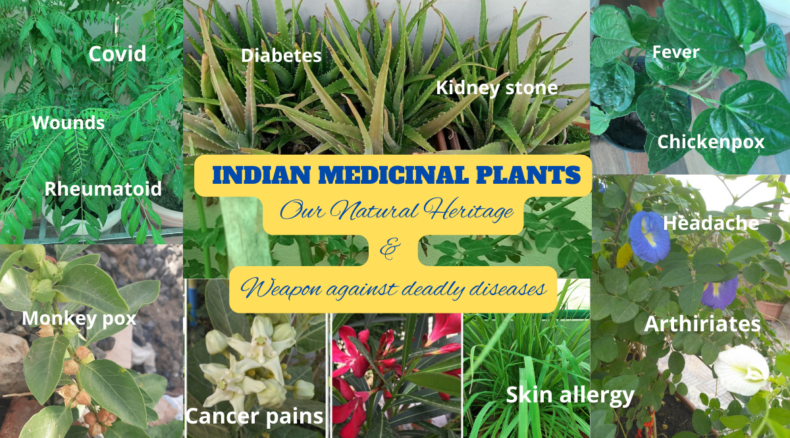GROWING IMPORTANCE OF MEDICINAL PLANTS
This planet’s spectacular web of life supplies countless gifts to humanity. Healthy wild ecosystems clean the water we drink and produce the air we breathe, the foods we eat, the medicines that cure and protect us, and the materials that form our shelter and clothing. “Indian medicinal plants provides hopesMedicinal plants have been widely used to treat a variety of infectious and non-infectious ailments. According to one estimate, 25% of the commonly used medicines contain compounds isolated from plants. “Indian medicinal plants provides hopes Several “plants could offer a rich reserve for drug discovery of infectious diseases, particularly in an era when the latest separation techniques are available on one hand, and the human population is challenged by a number of emerging infectious diseases on the other hand. The history of medicinal plants dates back to the origin of human civilization on earth. “Indian medicinal plants provides hopes”.

HERE IS THE LIST OF SOME IMPORTANT MEDICINAL PLANTS WHICH WE CAN EASILY GROW IN OUR HOME GARDEN ALSO –
| COMMON NAME | SCIENTIFIC NAME | USE |
| Aparajita – Shankhpushpi / Butterfly pea/ Krishnakanta/ Vishnukanta | Clitoria ternatea | In Fever, diarrhea, gastritis, nausea, vomiting & bleeding from anus,mania, schizophrenia & neurological disorders etc |
| China Rose – Gudhal | Hibiscus rosa-sinensis | Loss of appetite, colds, heart and nerve diseases, upper respiratory tract pain and swelling (inflammation), fluid retention, stomach irritation, and disorders of circulation |
| Patharchatta | Kalanchoe pinnata | In soothes any pain in joints or muscles, kidney stone, calm down redness, swelling and irritation in the skin, acidity, heartburn and aids in digestion. |
| Tulsi | Ocimum tenuiflorum | Used to treat skin problems like acne, blackheads and premature ageing. Treates heart disease, fever, and respiratory problems. |
| Ashwagandha | Withania somnifera | Calm the brain, reduce swelling, lower blood pressure, and alter the immune system. |
| Meetha neem | Murraya koenigii | Anti-diabetic, antioxidant, anti-microbial, hepatoprotective, hypocholesterolemic properties, used in many condition such as diabetes, boils, skin and healing wounds. |
| Baramasi – Sadabahar | Catharanthus trichophyllus | lower blood pressure & sugar levels, help reduce swelling (inflammation) and have a drying (astringent) effect on the tissues. |
| Ashok tree | Saraca asoca | Useful to manage female disorders like dysmenorrhea and menorrhagia due to its Vata balancing property. |
| Aloe vera – Gwar Patha or Ghrit Kumari | Aloe barbadensis miller | antibacterial, antiviral, and antiseptic properties. This is part of why it may help heal wounds and treat skin problems. |
| Haldi – Turmeric | Curcuma longa | In rheumatoid arthritis, chronic anterior uveitis, conjunctivitis, skin cancer, small pox, chicken pox, wound healing, urinary tract infections, and liver ailments. |
| Amla | Phyllanthus emblica | anti-diabetic, hypolipedemic, anti-microbial, anti-inflammatory, antioxidant, hepatoprotective and anti-emetic activities. |
| Ajwain | Trachyspermum ammi | Improve the flow of stomach acids, which can help to relieve indigestion, bloating, and gas. Help to treat peptic ulcers as well as sores in the esophagus, stomach, and intestines. |
| Giloy – Guduchi/Amrita | Tinospora cordifolia | Helps remove toxins, purifies blood, fights bacteria that causes diseases and also combats liver diseases and urinary tract infections. |
| Stevia – Sweet leaf/Candyleaf | Stevia rebaudiana | lowering blood pressure, treating diabetes, heartburn, high uric acid levels in the blood, for weight loss, to stimulate the heart rate, and for water retention. |
| Insulin plant | Costus igneus | Helps those suffering from diabetes. Used against ailments like cough, cold, skin infection, eye infection, lung diseases, asthma, uterine contraction, diarrhea, and constipation among others. |

This are very few important plants many such plants are around us with lots of benefits and importance just we need to realise. Like Camphor, Dalchini, Lemon grass, Jamun, Anar, Neem, Shatavari, Gotukola, Brahmi, Sahdevi, Lavender, Kaner, Aankda, Parijaat, Mint etc.

CONCLUSION – NEED TO PRESERVE OUR NATURAL HERITAGE
Medicinal plants are at increasing risk from destruction of their habitats, bioprospecting for new sources, and overharvesting of known medicinal species. Medicinal species are very profitable. This profitability can make traditionally used, accessible, and affordable medicinal plant resources less available to populations that have relied on them for centuries. The term “biopiracy” has been coined to describe the practice of private companies patenting traditional remedies from the wild and selling them at a vast profit, often allowing little or none of that profit to go back to the country or indigenous and local communities of origin. Medicinal plants have been used throughout the world, however, their wide usage had been limited to China, India, Japan, Pakistan, Sri Lanka, Thailand and a number of African countries. Developed countries are also turning to encourage the usage of plant-based natural medicinal product in their healthcare systems. Our responsibilities are clear, We must re-commit ourselves to conservation of our remaining wild species and wild places so that the loss of these resources is minimized. Nature’s Pharmacy is our Treasure Chest.

Social Media heading
- Indian medicinal plants
- Indian plants a natural treasure
Read More- Indian medicinal plants provides hopes against deadly diseases.













